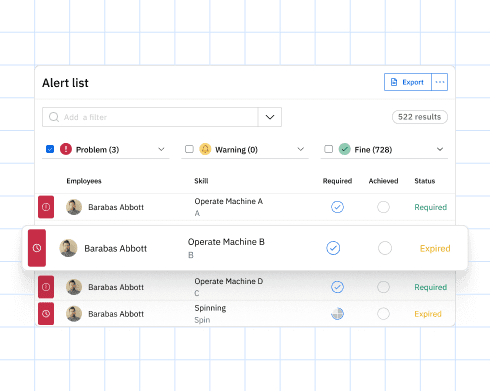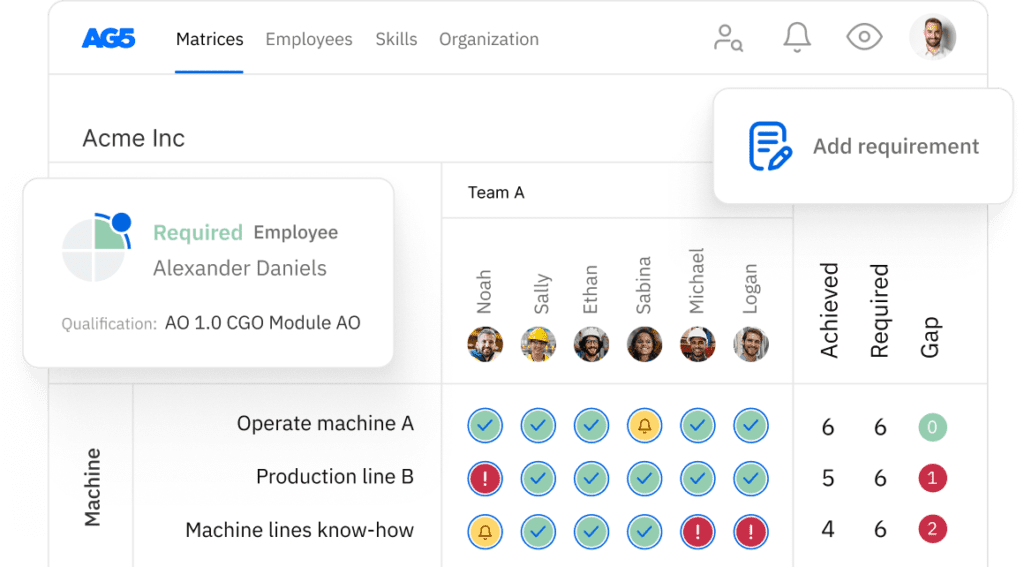How to conduct a training needs assessment
Want to identify and close skill gaps in your organization? A training needs assessment helps you do just that. In this article, we’ll cover what a training needs assessment is, why it’s important, and guide you through the process, step by step.

A successful skills management strategy hinges on your ability to identify and close skill gaps. To do so, you’ll need to perform a training needs assessment.
In this article, we’ll explore everything you’ll need to know, including the definition of a training needs assessment, the steps you’ll need to conduct one – as well as how AG5 can help you streamline the process.
What is a training needs assessment?Copied
A training needs assessment (TNA) is a process used to identify skill gaps and determine the training required to fill them. It helps organizations ensure employees have the knowledge and competencies they need to most effectively perform their roles. In this way, a training needs assessment aligns training programs with business goals.
A TNA is comprehensive, with a process that exceeds that of simple skills development. Its primary advantages include:
- Enhanced employee performance
- Improved organizational productivity
- Strategic alignment of employee skills and organizational goals
- Increased employee engagement and retention
- Greater organizational profitability [1]
How to conduct a training needs assessmentCopied
You can follow these general steps to conduct a training needs assessment in your organization.
Identify TNA objectives
The first critical step in a training needs assessment is establishing clear goals that align with broader business strategies. This requires a:
- Comprehensive analysis of current business challenges
- Thorough review of strategic organizational objectives
- Determination of the specific performance improvements you need
Be sure to set measurable outcomes for the assessment to ensure its effectiveness and continued relevance.
Gather skills-related data
Effective data collection for a training needs assessment involves both quantitative and qualitative approaches.
Quantitative methods provide objective, measurable insights into your workforce’s capabilities. These methods could include:
- Analyzing performance metrics
- Conducting skills assessments
- Reviewing productivity reports
- Reviewing employee performance reviews
Qualitative methods complement quantitative data through more nuanced – and potentially more subjective – approaches. These might include:
- One-on-one interviews
- Group discussions
- Employee surveys and self-assessments
- Feedback and observations from managers and team leaders
Conduct a skills gap analysis
To understand the types of training your employees should undergo, you must develop a clear picture of the skills they currently have, as well as those they need. You can achieve this by conducting a skills gap analysis.
A skills gap analysis quite an intensive process, but it is essential to a comprehensive training needs assessment. If you want to learn more or need guidance, read our blog, “How to conduct a skills gap analysis.”
Prioritize training needs
The results of your skills gap analysis will provide you with areas in which your employees need training. Rather than tackle all of these areas at once, you should prioritize the most important or urgent.
Be sure to consider:
- How critical a skill is to business operations
- A skill’s potential impact on productivity
- How a skill aligns with strategic objectives
- The cost of skill development
Develop your training plans
Once you’ve decided the training areas on which to focus, you’ll need to develop training plans and schedules for your teams or employees. The type of training will of course depend on the skills being developed, but often include:
- Workshops
- Online learning platforms
- Mentorship programs
- Hands-on practical training
- Peer-led learning sessions
Implement your training plans
The most successful training programs are those that are well-planned, flexible, and aligned with the goals of both individual employees and the organization – the latter of which is extremely important for boosting and maintaining employee engagement. [2]
Best practices for implementing training programs and initiatives include:
- Clear communication of training objectives
- Active management support and engagement
- Inclusive and accessible training programs
The goal is to create an environment that supports and encourages continuous learning.
Evaluation and continuous improvement
A TNA doesn’t end once training has been scheduled – or even completed. You should consistently conduct skills assessments, for example, so you can develop new training initiatives.
You’ll also want to refine your existing training programs to keep them current and updated with new technologies or industry best practices. This approach ensures that training remains dynamic, relevant, and aligned with evolving organizational needs – all of which will help you maintain a competitive edge. [3]
Training needs assessment levelsCopied
Like a skills gap analysis, you can conduct a TNA at different levels in your organization, depending on the scope of your training requirements or upskilling initiatives. Choosing the right level for your TNA will help you reduce costs and use time more efficiently.
- Organizational level. Identifies skills needed to achieve company goals. It considers industry trends, technological advancements, and overall business objectives
- Task level. Focuses on job-specific skills and competencies. It analyzes what skills are necessary for each role
- Individual level. Assesses an employee’s current skills compared to job requirements. It helps create personalized training plans
Training needs assessment free skills matrixCopied
Ready to conduct a training needs assessment? You can use our free, Excel-based training needs assessment skills matrix to get started. It comes pre-populated with more than 20 skills and certifications in the following categories:
- Manufacturing processes and systems
- Equipment operation and maintenance
- Quality control and assurance
- Health and safety compliance
While an Excel-based skills matrix is a great introduction to a training needs assessment, you’ll want a streamlined, more intuitive method of skills management as your organization grows or progresses. That’s where AG5 comes in.
You can use AG5 to:
- Create unbreakable skills matrices in just two clicks
- Map the skills, knowledge, and competencies present in your organization – as well as those that your employees need
- Replicate complex organizational structures with drag-and-drop menus
- Find the best replacements for employees off sick in a single search
- Enter updates and training results from the shop floor in real time
- Match projects to specific employees’ expertise and experience
- And more
Want to see how this could work in your organization? Schedule a free, live, 15-minute demo for a custom look.
Sources Copied
- Change view: Table
-
APA
| # | Source title | Description | Publication | Retrieved | Source URL |
|---|---|---|---|---|---|
| 1 | Improve Work Performance With a Focus on Employee Development | Gallup | December 12, 2019 | April 3, 2025 | https://www.gallup.com/workpla.. |
| 2 | Employee Engagement Is Vital For Successful Training Initiatives | Forbes | August 21, 2024 | April 3, 2025 | https://www.forbes.com/council.. |
| 3 | How continuous improvement can build a competitive edge | McKinsey | May 6, 2019 | April 3, 2025 | https://www.mckinsey.com/capab.. |
Author Copied
Revisions Copied
Written by: Rick van Echtelt
Copy edited by: Adam Kohut

